#bonchamps
Explore tagged Tumblr posts
Text
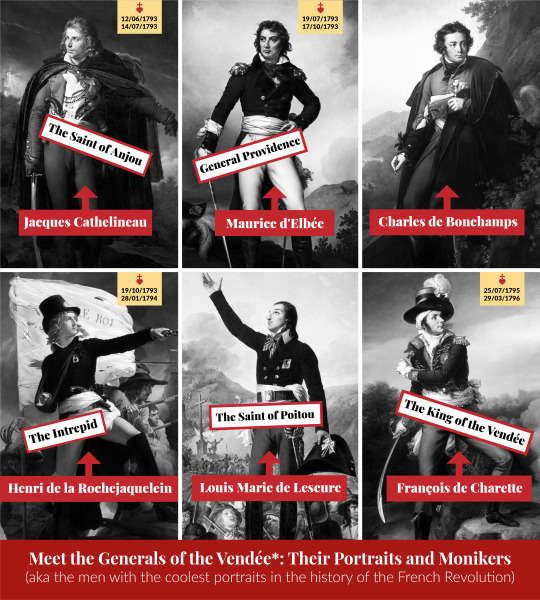
I'm still neck-deep in my studies of the Vendée, and what I've found particularly fascinating is that nearly every (1) prominent general not only boasts an impressively cool portrait but also sports a rather fetching nickname.
The nicknames are sourced from the Memoirs of the Marquise de La Rochejaquelein. How reliable is she? The lady lost her father and both her husbands in two separate Vendéen royalist uprisings, so she's hardly an unbiased chronicler. However, it's a reasonable assumption that, irrespective of one's views on the beliefs of these six men, they exhibited considerable courage and grace in their tragically brief lives—something even their Republican foes, begrudgingly, acknowledged.
Moreover, even if the cool monikers might be embellished, they're somewhat incidental to the broader mythos surrounding the Vendéen generals(2)
The truly intriguing part is the blatantly obvious piece of Royalist propaganda embodied by the six portraits and what they reveal—not so much about the portrayed subjects, but about the man who commissioned them: Louis XVIII (3).
Every Vendée General needs a Good, King-approved, Profile Picture
Now, I'm no expert on Louis XVIII, but he seems considerably more sensible than either one of his brothers. During their reigns, both the previous Louis and the subsequent Charles X appeared to have missed the memo that the times were changing, managing to piss off masses of people. Louis XVIII, in contrast, was painfully aware of the precariousness of his position. These portraits show as much.
Understandably, imagery during the First Empire tended to avoid commemorating the Revolution or acknowledging its victims. The Bourbon Restoration opted for a different tack: it sought to acknowledge the allegiance to the crown of those who opposed the revolution without reminding the public of the implications of such loyalty: namely war; a very bloody war.
In 1816, Louis XVIII commissioned a series of portraits to adorn the Hall of the Guards at the Palace of Saint-Cloud, depicting generals of the Vendée. Since he is often (apocryphally) quoted as saying that he owes his crown to the Vendée, the subject matter makes sense. The result, as you can see, was suitably glorious (4).
However, comparing these paintings to those of the Vendée created during the Third Republic by artists like Julien Le Blant, Paul-Émile Boutigny, Alexandre Bloch and many more reveals a notable omission: the blood, the violence, the enemy. Now, before you argue that it's just the era's style, go take a look at some of the paintings of Napoleon’s generals—many depict the enemy lurking ominously in the background. Yet, for portraits of six men who fought in a conflict so brutal it's sometimes termed a genocide, these images are remarkably sedate.
*Spoiler Alert*: It’s intentional.
Louis XVIII wasn’t an idiot. He clung to the throne by the skin of his teeth. Now, I’m speculating, but he probably liked his head enough to want to keep it firmly on his shoulders. He might have been grateful to the Vendéans and eager to indulge in a bit of old-fashioned Royalist propaganda, but he wasn’t about to spark another civil war over it.
Thus, these portraits, intentionally devoid of any overt warfare imagery, focus instead on symbols of monarchy and religion. We see the white flags of the Bourbon kings, rosaries, sacred hearts and white cockades adorning men who appear more like martial saints than soldiers.
Bonchamps's portrait lacks even a weapon (he holds a quill). In his painting, Cathelineau (5) is so laden with rosaries and crosses he might as well have raided the Vatican Gift Shop. Lescure's portrait drowns in Christian symbolism to the point of satire. Charette appears to be triumphant and is dressed in the outfit he had on when he entered Nantes after the Treaty of La Jaunaye. D’Elbee is an outlier, painted during the reign of Charles X after a decade of rosaries and white cockades, allowing the artist some leeway with the excessive symbolism.
Of all the portraits, that of Henri de La Rochejaquelein by Pierre Narcisse Guérin(6) stands out as the most striking. The young leader is portrayed in a dynamic posture, which projects a sense of forward movement and leadership yet avoids any overt display of aggression. La Rochejaquelein is the only one clearly portrayed amidst battle, in a heroic poise, aiming his gun at an invisible off-the-canvas enemy. Guérin gives us just a hint of the Republican army by showing the tips of Republican bayonets in the background—just enough to suggest opposition, yet not enough to relive the battles.
Notably, while dripping in Royalist symbols, his portrait eschews overt religious iconography beyond the Sacred Heart. In fact, the painting goes so far as to replace what is known to be La Rochejaquelein’s flag with a more royalist-focused one.
The Conspiracy of La Rochejaquelein’s flag
How do we know this? Well, the actual flag was preserved by the Beauregard family, whose ancestors held commanding roles in the Vendéen army. What’s written on the flag is not “Vive le Roi” (7) but “PRO ARIS REGE ET FOCIS”, translating to “For Our Altars, King, and Hearths”. Notice the order—king follows altars? Now, before you suggest that neither Guérin nor Louis XVIII could have known what was inscribed, I will concede that Guérin might not have, but Louis XVIII actually handled the flag a year before commissioning the portrait.
After Rochejaquelein's death, his comrades took the flag to Charette's army, which continued to use it. In 1814, one of Charette's former officers presented it to Louis XVIII. The king then gifted it to Louis de la Rochejaquelein during the 1815 uprising. After his demise at the Battle of Les Mathes, Auguste, the last of the three La Rochejaquelein brothers, preserved it until 1832 before, prior to his exile, bequeathing it to the Beauregard family, to whom he was related.
So, putting my metaphorical tinfoil hat firmly in place, I will conclude that it seems the King didn't want to share the dashing young Compte de la Rochejaquelein with the Pope.
Jokes aside, Rochejaquelein’s portrait was the first completed, likely reflecting the true intent of the King’s propaganda effort: to reaffirm a Royalist identity and provide a heroic image that could encourage unity rather than division. Over time, the overt Royalist symbols were toned down—probably because someone hinted to the king that he was being a bit much—but one element remained consistent: the absence of violence.
The remaining five Vendéean generals' portrayals as dignified, pious leaders rather than battlefield warriors are a rather perfect metaphor for the narrative Louis XVIII sought to promote throughout his reign—a narrative of reconciliation, remembrance, and a gradual, non-confrontational restoration of the monarchy to what he perceived as its rightful, almost divine, station. Essentially, Louis XVIII was too smart and fond of his head and crown to go all-in on the whole absolutist monarchy thing (8).
... If you've actually made it this far and read this whole thing, please know you're one of my favourite people in the whole wide world...
Notes:
(1) Apart from Stofflet, for reasons I won’t speculate on here because this thing is already over 2000 words long…
(2) This was all I intended to mention before I tumbled down a rabbit hole into the realm of early Restoration imagery and emerged with a mini-essay on early Restoration propaganda...
(3) the former Count of Provence and brother to the guillotined Louis XVI)
(4) The Louvre Collection has a number of paintings marked as being commissioned for the guard room in Saint Cloud. In chronological order, they are:
Henri Duverger, comte de La Rochejaquelein - Guérin, Pierre-Narcisse (1816)
Louis-Marie de Salgues, marquis de Lescure (1766-1793), général vendéen by Lefèvre, Robert (1816)
Charles-Melchior-Artus marquis de Bonchamps (1760-1793), général vendéen by Girodet de Roucy-Trioson (1816)
Jacques Cathelineau (1759-1793) généralissime vendéen by Girodet de Roucy-Trioson ( comissioned in 1816 but exposed in the Salon of 1824)
Pierre Jean Baptiste Constant, comte de Suzannet by Mauzaisse, Jean Baptiste(1817)
François Athanase Charrette dela Contrie by Guérin, Paulin (1819)
Louis Duverger, Marquis de La Rochejaquelein by Guérin, Pierre-Narcisse (1819) – this is Henri de La Rochejaquelein’s baby brother, he died leading the Vendee revolt in 1815
Louis, comte de Frotté, général vendéen by Louise Bouteiller
Maurice Joseph Louis Gigost d'Elbée by Guérin, Paulin (1825) – Comissioned by Charles X
Antoine Philippe de la Trémoille, prince de Talmond, général vendéen by Cogniet, Léon - (1826) – Comissioned by Charles X
Louis-François Perrin, comte de Précy (1742-1820), général vendéen by Dassy, Jean Joseph (1829) – Comissioned by Charles X
(5) Fun fact: Cathelineau’s son stood for his father’s portrait
(6) Not to be confused with Guérin, Paulin
(7) According to his wife, this would have been Lescure's flag
(8) Very in character for a king who refused to be crowned. And this is a good thing. Especially seeing how his little brother turned out…
Sources:
Crosefinte, Jean-Marie. Les Drapeaux Vendéens.
La Rochejaquelein, Marie-Louise-Victoire. Memoirs of the Marquise de la Rochejaquelein.
Mansel, Philip. Louis XVIII.
#frev#french revolution#vendee war#vendee#la rochejaquelein#cathelineau#d'elbee#bonchamps#lescure#charette#restoration#louis Xviii#royalist#amateurvoltaire's essay ramblings
26 notes
·
View notes
Text
RENÉE BORDEREAU // SOLDIER
“She was a French soldier. She followed her father, disguised herself as a man, and fought as a Royalist cavalier in the troops of Charles Melchior Artus de Bonchamps during the Vendéan insurrection against the French Revolution, and took part in all battles of the war.”

7 notes
·
View notes
Text

BONCHAMP LES LAVAL - Mayenne
Le promoteur offre la remorque ?
6 notes
·
View notes
Text
Sainte Garce - Laurent MAILLARD - 2023 - Ed. Et le bruit de ses talons
Quatrième de couverture Fugue ? Enlèvement ? Elsa Bonchamps, une étudiante parisienne, disparaît sans laisser d’adresse. Désemparée, son amie Pauline décide pour mener l’enquête, de s’en remettre à Aurélie Van-Root, ex-tueuse, alias Marlène Gauchet. Après Paris, les recherches d’Aurélie l’amènent rapidement à retrouver la trace d’Elsa à Trehonët, petite bourgade du Morbihan. Tout comme Elsa,…
#disparitions#etlebruitdesestalons#instalire#instalivres#leeham#leschroniquesdeleeham#littérature#read#romans#suspens#thriller
0 notes
Link
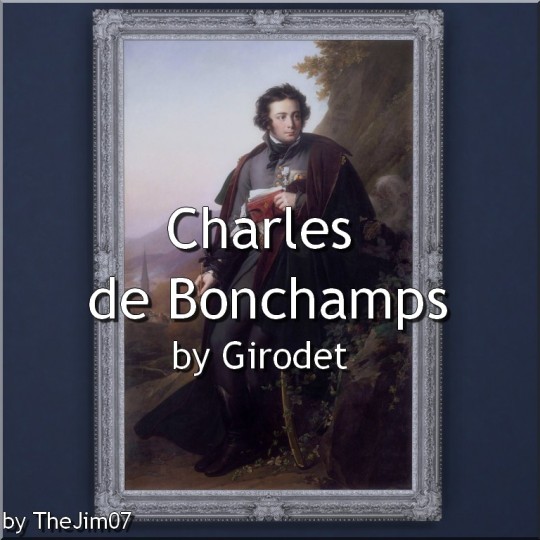
Hi everyone
Charles Melchior Artus, Marquis de Bonchamps (1760–1793), was a French politician and leader of the Vendean insurrection of Royalists against the Republic during the French Revolution.
This portrait was made by the French artist Anne-Louis Girodet Roucy-Trioson in 1824. It is currently exhibited at the Museum of Art and History in Cholet, France.
Charles Melchior Artus de Bonchamps (3100§/Env.8) - Painting - 8 swatches
Happy Simming
Jim
Polygon Counts:
High/Med/Low
38/38/38
Additional Credits:
TSRW, S4S, S4PE.
EA/Maxis for wood texture from TS3.
Faithful reproductions of two-dimensional public domain works of art are public domain.
26 notes
·
View notes
Photo








Les Vendeens comme les chouettes )
#war of the vendee#guerre de la vendee#vendeen#d'elbee#bonchamps#charette#cathelineau#cadoudal#la rochejaquelein#lescure#talmont
63 notes
·
View notes
Photo


"Tête de Bonchamps Mourant" et "La Mort du Général Bonchamps" de Thomas Degeorge (circa 1830) dans les Collections Permanentes du Musée d'Art Roger-Quilliot de Clermont-Ferrand, Auvergne, France, juin 2020.
#expos#style#Bonchamps#Degeorge#MuseeArtRogerQuilliot#AuvergneAubrac#XVIIIe siècle#peinture#hommage#beauté
0 notes
Text
Le Pardon de Bonchamps
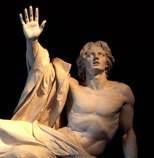
Very eloquent, this grave to the glory of the Vendean leader was paradoxically created in the XIXth century by the descendant of one of his enemies. Like a sign of reconciliation, it is under the strokes of a republican soldier's son that his block of marble morphed into the apotheosis of the royalist general, and, through him, into the celebration of triumphant goodness and humaneness.
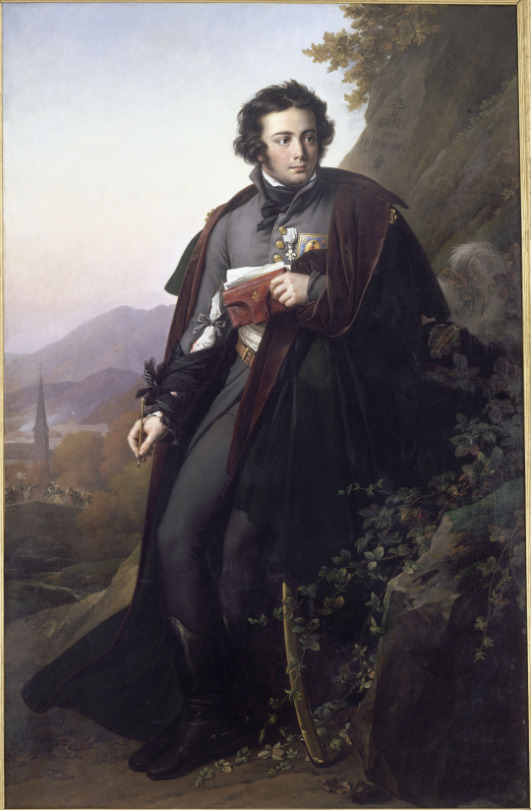
Charles Melchior Artus, Marquis de Bonchamps, was born in 1760 in Jurvadeil (Anjou). He served in India and was a member of the royal army when the French Revolution broke out. He took refuge in his estate of La Barronière where revolted peasants came in 1793 to ask him to lead them. He invested part of his personal fortune to equip his little contingent. A cautious general, he regularly faced the Republican troops without fate being always favorable to him.
On October 17, 1793, he takes part to the undecisive battle of Cholet which ends up in a vendean defeat. The insurgents leave around 8000 men on the battlefield. Bonchamps is fatally wounded. The Catholic and Royal Army withdraws on St Florent le Vieil with 5000 prisoners and the general in agony.
Defeated, the Vendean peasants, sickened by the loss of their comrades, want to avenge them by executing the republican prisoners. The slaughter is prepared, the city is furious, the bloody intent of his men reaches up a dying Bonchamps. Horrified by this behavior, he gives his last order - grace for the prisoners! His cousin d'Autichamp jumps on his horse and rushes toward those who were about to do something irredeemable. The unexpected, merciful order bursts out and spreads like wildfire into the city : “Grace! Grace for the prisoners! Bonchamps wants it! Bonchamps commands it!" This event became a real idealized image of the history of the Wars in Vendée, the parallel being very clear for the partisans of the Catholic and Royal Army between the dying Bonchamps' forgiveness and the words of Jesus dying on the Cross: "Forgive them, for they don't know what they are doing".
The general's last will is respected and the republicans freed against the oath that they will never again serve against the vendean armies. Bonchamps breathes out his last on October 18 and is buried in St Florent le Vieil. Bonchamps's charity wasn't especially rewarded, the republican soldiers were forced to take arms again against those who had spared them, and they were given the instruction not to mention this act of generositye. They were told to say they were saved from the clutches of the rebels by the republican army. It is sometimes difficult to admit what's good when you find it in your worse enemy...
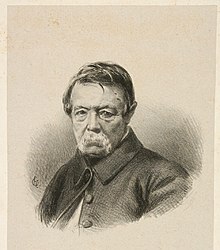
(David d’Angers (1847), lithograph by Henri-Charles Oulevay)
Pierre Jean David, called David d'Angers, didn't take part in the events since he was born in 1788. A sculptor, he begins his career under the First Empire (he will then work on the friezes of the Arc de Triomphe). He continues his career under the Restauration and even becomes a teacher in the Ecole des Beaux Arts de Paris.
When in 1817 a subscription is launched to build a grave for General Bonchamps, David shows a great eagerness to participate to the undertaking. Why ? Simply because his father was one of the 5000 prisoners owing their life to this man...
He creates the grave (1825), choosing of course as a subject this scene which saved his father: Bonchamps on his death bed rises and raises his hand to halt the incoming slaughter, his lips opening to deliver the sentence carven in the tomb." Grâce aux prisonniers!" The style is perfectly neoclassic, the wounded is an opportunity to work on a body that is glorified in his heroic nudity and the drapery in a sheer style antique. The face is already showing a certain baroque romantism: the loose hair, the face contracted by a pain that seems to be as much the physical pain of agony as the moral pain about men's behavior. His lips let out his last breath, which, taking the life of one man, saves 5 000.
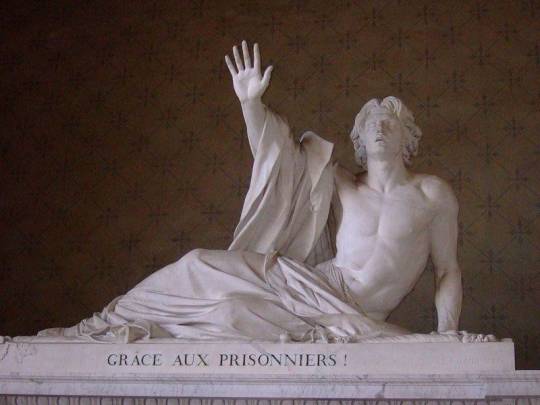
The grave is still visible today in the church of St Florent le Vieil, a copy is displayed in the museum of Angers.
Translated from this article: Source
"Bonchamps was the one that the Rebels cherished the most and to whom at the same time the greatest talents were granted."
Jean-Baptiste Kléber
#french revolution#guerres de vendée#charles melchior artus de bonchamps#david d'angers#battle of cholet#sculpture#arts and crafts#xix#le pardon de bonchamps#today in history
16 notes
·
View notes
Text
...qui lo raggiunsero nell'ordine:
sindaco con fascia tricolore,
ministro della Marina mercantile,
centoduenne baronessa Filiguelli di Bonchamp mascotte a vita della società

8 notes
·
View notes
Text
10 mai 1760, naissance de Charles de Bonchamps à Juvardeil. Général de l’Armée Catholique et Royale, Bonchamps est célèbre pour avoir grâcié 5000 soldats ennemis républicains à la suite de la bataille de Cholet du 17 octobre 1793. Lorsque la Convention apprend que les prisonniers républicains ont été grâciés par un catholique, le député républicain Merlin De Thionville donne l’ordre que cette nouvelle soit aussitôt étouffée et surtout ne soit pas racontée dans aucun journal. Plus tard, après l'enterrement de Bonchamps, les barbares républicains acharnés et haineux l'exhument pour lui trancher la tête qu’ils envoient à Paris par vengeance.
4 notes
·
View notes
Photo

A Boma in the Forest. Illustration Published 1892 in Paris in Édouard Charton's Tour Du Monde Magazine ('around the World'), to Go with An Article on the Stairs Expedition to Katanga Written from the Journal of Explorer Christian De Bonchamps., Edouard Riou
https://www.wikiart.org/en/edouard-riou/a-boma-in-the-forest-illustration-published-1892-in-paris-in-edouard-chartons-tour-du-monde-magazine
7 notes
·
View notes
Text
RENEE BORDEREAU // SOLDIER
“She was a French soldier, nicknamed the Angevin. She followed her father, disguised herself a man, and fought as a Royalist cavalier in the troops of Charles Melchior Artus de Bonchamps during the Vendean insurrection against the French Revolution, and took part in all battles of the war. She reputed to have killed some 20 of the opposing army, including slitting the neck of her own uncle who was a republican.”

0 notes
Text

Napoléon Ier donne audience à la comtesse de Bonchamps, 1804 by Frederic Legrip (1863). It looks like he is doing another good deed!
34 notes
·
View notes
Photo






Pinçon des arbres, Bergeronnette, .....et autres oiseaux de la campagne de Bonchamps
1 note
·
View note
Text
Une femme a été blessée dans un incendie de cuisine près de Laval
Une femme a été blessée dans un incendie de cuisine près de Laval
Un habitant de Bonchamp-lès-Laval (Mayenne) a été transporté à l’hôpital de Laval le dimanche 14 août 2022. Elle a été blessée dans un incendie qui s’est déclaré dans sa cuisine.Juste avant midi, les pompiers de Mayenne ont été alertés d’un incendie dans un pavillon de la rue Planté à Bonchamp-lès-Laval (Mayenne). La femme hospitalisée Le feu s’est déclaré “dans la cuisine” de la maison, mais…

View On WordPress
0 notes
Text
EMPLOYE BOUTIQUE (H/F)
Job title: EMPLOYE BOUTIQUE (H/F) Company: Food Intérim Job description: Le poste Nous recherchons pour une station service un employé boutique (h/f) Vous aurez pour mission : – L’encaissement – réception des marchandise – Réassort de la superette – Rangement, entretien des locaux Le profil recherché … Expected salary: Location: Bonchamp-lès-Laval, Mayenne Job date: Sat, 23 Oct 2021 07:58:40…
View On WordPress
0 notes